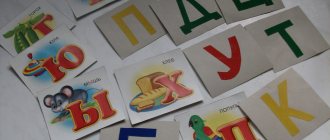Sounds of the Russian language
Our speech consists of words that are combined into a sentence. Each word can be considered as a semantic component of a sentence, filled with content, and also as a sounding object.
A word can be divided into syllables, which are made up of individual sounds. From a phonetic point of view, a word is made up of sounds.
Sound is the basic unit of language, just like words and sentences. Sounds form words at the phonetic level. Sounds, depending on their set, quantity, and location in a certain sequence, help to distinguish one word from another:
- treasure - contribution;
- crown - crown;
- cat - current.
Depending on how sounds are formed in the speech apparatus, vowels and consonants are distinguished in the Russian language.
The vowel sounds [a], [o], [e], [u], [i], [s] consist entirely of voice. When they are formed, air passes freely through the tense vocal cords and mouth, without encountering any obstacles on its way. In Russian, vowel sounds are musical. You can drag them out for a long time and sing: a-a-a, o-o-o, o-o-o.
Vowel sounds form a phonetic syllable in a word, but consonants cannot form it. When syllabled, they are combined with vowel sounds in pairs or whole groups:
- collar - collar;
- beauty - beauty.
When to start training?
In fact, the initial stage of learning occurs at an even earlier age, when we teach the baby to distinguish between different sounds. Then we study all the letters of the alphabet, give the concept of vowels and consonants, and teach the child to determine the presence of each of them by ear. Only after this will the baby be able to understand the difference between voiced and deaf and learn to hear them in words.
That is, first you need to develop phonemic hearing in a preschooler - that same ability to isolate individual sounds from speech. How to do it?
- Teach to respond to the sound of rattles by turning your head in their direction.
- We teach a grown-up toddler to listen to nature outside the window: let him close his eyes and describe what he hears (the hum of the wind, the rustling of leaves, the chirping of birds, the noise of cars, barking dogs, etc.).
- We do the same with household appliances at home: let them distinguish the sound of a hairdryer, vacuum cleaner, kettle, refrigerator.
- We play at the zoo: the mother imitates the voices of different animals and birds, and the child guesses them, and then vice versa.
- Let the blindfolded child determine what sounds: a bell, a tambourine, a whistle, etc.
- After he has learned all the letters, you can teach him to identify their presence in words (for example, have him clap or stand up if he hears a given sound).
That is, before studying the voicedness - deafness of consonants, a preschooler must:
- know all the letters of the alphabet, their order, quantity;
- distinguish vowels from consonants;
- have developed phonemic awareness.
All these skills can be developed in a preschooler by the age of 5–6 years.
In order for your baby’s phonemic hearing to develop correctly, try to communicate with him as much as possible, and also make sure that there is no constant background noise around him (a TV that doesn’t turn off, a music player).
Consolidating knowledge
You can consolidate the material covered by asking your child to compile and fill out such a table. This will also connect motor memory.
A good way to learn to distinguish consonants is to play “dispersing” sounds into “apartments” in a drawn “house”. For example, voiced unpaired ones - in apartments with blue windows, paired ones - with yellow and orange ones, unpaired unpaired ones - with green ones.
It is useful to look for different letters in words. You can give your child examples of words with voiceless consonants, then with voiced consonants, and show that both words can end at the end. You can show how the sorceress Phonetics turns deaf into voiced and vice versa.
Let the sign drawn by the child always hang before his eyes, so that he can periodically return to it and repeat the material. For a child, first of all, it will be a game, but with its help he will study an important topic that will be very useful for him in his studies.
Let's sort out the pairs
To make it easier to remember paired and unpaired deaf and voiced sounds, we connect vision. Let's visualize pairs of consonants in table form.
For this purpose, you can compose a phonemic tale about how vowels and consonants lived in the Russian language, some consonants had siblings, while others did not. We draw two icons on the left side of the sheet that will indicate voicedness and deafness (for example, a bell and headphones). Opposite the bell we write the ringing ones, opposite the headphones – their deaf brothers. Count together how many pairs of brothers are there in our language? That's right, 6. Let the child visually see which letters are paired.
Sometimes brothers change places in words. For example, a paired voiced voice at the end of a word becomes voiceless (tooth, shore, train), and paired voiced voices before other voiced ones become voiced (backpack, request).
But there are consonants that do not have brothers. They do not turn into anyone and therefore are friends only with “their own”. Now in the table we add unpaired voiced ones above the voiced ones, and unpaired voiceless ones under the voiceless ones. With such visual perception, it will be easier for the child to remember the rule: M, L, N, R, Y - only voiced ones, X, C, Ch, Shch - only deaf ones.
Consonants
Consonant sounds constitute a larger group of the phonetic structure of the Russian language. There are 36 of them. Compared to vowels, consonant sounds have a different quality. They are pronounced muffledly and are formed with little participation of the voice, which is necessarily accompanied by noise. Noise occurs if, when pronouncing a consonant sound, a stream of air encounters an obstacle in the form of a raised tongue, rubs against the walls of the cheeks, as a result of closing and opening the lips, etc.
Definition
Consonants are sounds that are formed by noise.
According to the degree of participation of voice and noise, consonant sounds are divided into sonorant and noisy .
Sonorant sounds are sounds in which noise is minimal and the voice predominates.
Let's list the sonorant sounds:
[th'], [l], [l'], [m], [m'], [n], [n'], [r], [r'].
According to the relationship between voice and noise, noisy consonants are also divided into two groups:
- voiced consonants;
- voiceless consonants.
Voiced consonants
Compared to sonorants, in voiced consonants, during their formation, noise prevails over voice. In Russian, the following sounds are voiced:
[b], [b'], [c], [c'], [d], [g'], [d], [d'], [g], [h], [z'].
They are paired based on hardness and softness:
- [b] - [b']
- [in] - [in']
- [g] - [g']
- [d] - [d']
- [z] - [z'].
Only the voiced consonant [zh] is always hard and has no pair for softness:
- millstone [z o r n o f]
- lived [lived].





